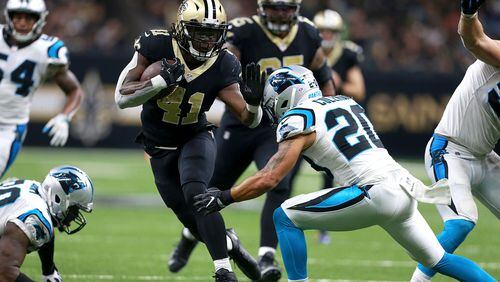It’s not like the Falcons haven’t squared off against a two-back attack before, but they’re about to face a monster (or two) of supreme sorts Thursday night when the devilish Saints visit Mercedes-Benz Stadium.
New Orleans running backs Mark Ingram and Alvin Kamara together are playing like the source code for a video game.
Consider how well-respected the Falcons’ tag team of running backs Devonta Freeman and Tevin Coleman is around the NFL. Then, start worrying about how their 1,539 combined yards and 12 touchdowns from scrimmage stack up, or down, against the 2,397 and 20 touchdowns pedaled by the firm of Ingram and Kamara.
Freeman said he doesn’t pay much attention to other running backs, yet he acknowledged this week that Ingram and Kamara are “doing their thing.”
Yeah, those dudes in Sunday’s 31-21 win to sweep the Panthers became, according to the Elias Sports Bureau, the first NFL teammates in 32 years to each put up 100 or more yards from scrimmage in four consecutive games.
And it’s not just because both fireplugs run the ball well.
Kamara, a 5-foot-10, 215-pound rookie from Norcross High School, who played at Alabama and Tennessee and who lasted until the third round (No. 67 overall) before the Saints drafted him, not only leads the NFL with a 7.0-yard average per carry. He’s caught 59 passes, 18 more than Coleman and Freeman.
Ingram has 42 receptions, one more than Coleman and Freeman together.
The Saints backs do just about everything together, including postgame interviews. They’re kind of funny.
So, you just know that Saints coach Sean Payton and offensive coordinator Pete Carmichael are going to be swinging the ball to the Saints’ backs, except that Kamara is a threat to go vertical just as much as horizontal.
He already has 616 receiving yards, which would rank second on the Falcons, and is the third NFL rookie ever to have 600 yards both receiving and rushing.
And New Orleans has four regular-season games to go.
“(Payton) likes to get the ball to them not only in the run game, which they're great at as well, but in the passing game,” Falcons defensive coordinator Marquand Manuel said. “They can line up as wide receivers.”
Really, the 5-9, 215-pound Ingram is not likely to split out wide.
He’s more involved as a screen receiver, having caught 46 passes last season and 50 in 2015. Kamara is a bigger threat there, and perhaps a little speedier. Plus, he flashes a gold grill in his mouth to complement his nose ring.
“(Kamara) is used more sometimes like a Y-receiver, and (Ingram) is more a traditional back than a receiver,” Falcons safety Ricardo Allen said. “He’s one of the guys who ... can split out as a wide receiver.”
Several Falcons defenders consider the Saints’ running backs nearly identical in their skills sets, although end Derrick Shelby sees differences.
“Kamara’s more of a receiver, but he runs the ball as well; more perimeter runs, kind of sticks it (inside) there every now and then,” he said. “For the most part, Ingram is involved in the passing game as well, but not as much as (No.) 41. He’s more of a power back, but he can still break away and get away from people.”
De’Vondre Campbell first suggests that the Saints’ backs are, “Nothing different; they really just complement each other really well,” but upon further questioning acknowledges their differences.
Kamara runs wider varieties of pass routes than Ingram, and he is more likely to run wide.
For the Falcons’ defense, “It’s identifying who’s in the game and then knowing like what plays they can run with those guys in the game,” Campbell said. “With Ingram in the game ... the probability of them running the ball goes up.”
That’s true.
Ingram, a first-round draft choice in 2011 out of Alabama (No. 28 overall), leads New Orleans in rushing with 922 yards on 180 carries, while Kamara backs him up with 606 yards on 86 carries.
Falcons coach Dan Quinn respects the ability of both Saints backs to break tackles, and that’ll be especially important Thursday night.
Kamara was hit hard at the goal line Sunday against the Panthers, yet rolled off and scored.
That game may have been a perfect encapsulation of the Ingram/Kamara effect as Ingram rushed for 85 yards and caught 37 yards of passes with a touchdown, and Kamara rushed for 60 yards and two touchdowns while adding 66 receiving yards.
“I would say the thing that has really jumped out to me, not just from (Kamara’s) Tennessee days ... is his balance,” Quinn said. “You know, I don’t know how many missed tackles you could track on a player, but I bet he would have one of the highest out there.
“It’s because of his balance that he can stay, you know, with contact and stay on his feet to extend plays.”
Add crafty Saints quarterback Drew Brees into the mix, consider his ability to read defenses and run multiple plays to one side of the game to give an opponent a certain look, and then fake it and go back the other direction to create one-on-one tackle situations, and the Falcons have plenty about which to be concerned.
“Tackling is important in any game, especially when you run like a cover-3 defense and teams are going to find a way to flood our zones and get one-on-one tackles,” Allen said. “We know for sure Drew is going to try to flood the zone and get his one-on-one matchup.”






